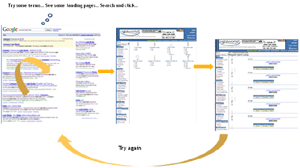End-to-End Search Marketing and Customer Experience
Summary of Survey Results
There is no question that search drives revenue: it brings customers to your site, it connects customers to products, and it can be used to trigger relevant offers on your site. Making the most of your search opportunity isn’t simple: you have SEO, paid search, paid inclusion, advertising, site search, and site merchandising. All seem to have different paradigms, tools, reporting, and lingo, and making trade-offs can be a challenge that few people we surveyed were able to successfully surmount. But there are steps you can take to optimize your customers’ search experience and reap increased and more profitable revenue as a result.
WHY THE SURVEY
Search should be one of your top marketing tools. Unfortunately, it is probably at least four or more of your top marketing tools: search engine advertising (SEM), optimized search engine ranking (SEO), paid inclusion, specialized landing pages or microsites, and merchandising on your site based on customers’ search and navigation actions. The tools and services currently available, as well as organizational structures, create the current barriers to managing and optimizing search marketing.
In April 2008, we conducted a survey to understand how people are managing search marketing across the interaction cycle and across their product lines. 52 people managed to complete most of the survey, making it the least popular survey I’ve ever created. Perhaps people found my vision a bit futuristic, or perhaps the questions looked uninviting. Setting aside my wounded feelings, I here summarize the ideas driving the uninviting survey questions, highlight some of the more startling responses, and then provide the entire survey response summary in the Appendix.
The bottom line is that, while merchants have a competent grip on their top sellers and top searches, the long tail is unmanaged and unmerchandised. And, almost no one is in position to optimize search marketing investments across the interaction cycle.
END-TO-END SEARCH
Customer’s Perspective
Your customer experiences your SEO, SEM, site search, landing pages, and navigation investments as he executes his journey from Internet search engine to final decision.
The ideal, from the customer’s perspective, is that the product (or other content) he is looking for appears in the top five search results, that the link takes him to a page that is entirely about the subject that interests him, that he is guided to select the items most suited to his situation, and that he chooses all the items that he needs in order to be successful. If this can be accomplished quickly, he would like it to be easy to satisfy his “back burner” items, items that are in the category of “while I’m here, and since I have the time, I might as well.”
Merchant’s Opportunity
It shouldn’t startle you that the customer’s ideal is pretty much the merchant’s ideal. Merchant’s want to be in the top search results, want to provide a focused landing page, want to help customers make the right decisions, want to present the right complementary items, and want to make great cross-sell offers.
End-to-End Search Experience
© 2008 Patricia Seybold Group
Illustration 1. A customer very likely begins his search on Google or another Internet search engine, as in the left hand panel. He may try several searches before seeing results that seem useful. He selects a result and investigates the link, probably abandoning it for another search result if the link does not look promising. He may do one or more searches at the site he links to. If he still is not satisfied, he might return to Google and perform another search.
If only it were that easy.
INTEGRATION IMPLICATIONS
Mechanics
If we are to deliver anything close to the customer’s ideal experience, and seize the opportunity to achieve revenue, conversion, and order value goals along the way, there are some mechanics to be solved.
First, words must be carefully chosen—words used for bids, ad copy, and page content. Rather than applying your creativity, use the top converting search words, the most popular site search words, and the top referring and converting Internet search words. You need to be able to associate these clumps of words with specific items,
Second, a Web search result link must take customers to the perfect page. The page must be all about what the customer is seeking, and it must be obvious that it is all about the customer’s topic. If the customer is looking for a stove, even though what he really wants is a cook top, the heading for your cook tops should be “Most Popular Stoves.” Use customer’s search words to create the right page. Provide interesting, useful navigation paths. Make engaging offers, triggered by customer’s search and navigation steps.
Third, it is obvious that automation is a must. The long tail is really long: the most popular searches on your site are only a handful of the total searches. There are tens or hundreds of thousands of searches performed on your site, and all but a handful are important. (A few searches are by people who arrived by accident and will leave as soon as they realize they don’t belong). You cannot manually associate search words with all of your items, manually create landing pages for every one of the 10,000 or 100,000 searches occurring on your site, manually optimize pages to rank well for customers’ search terms, manually identify the winning cross-sells and the must-have complements. Rules-based approaches allow you to rank items by popularity and create at least some kind of offer on key pages, but the vast majority of searches and offers will yield mediocre presentation.
In your toolkit, you need automatic creation of landing pages for every customer search, optimized using the search terms, presented to Web crawlers. You need automatic A/B testing for every variation introduced to the site, and automatic selection of the winning approach. You need tools that monitor, measure, analyze, and report on your ROI for SEO, SEM, paid placement, site search, and site merchandising. The reports should tell you what product lines are not performing well, what items customers want that you aren’t carrying, where offers are performing well and not so well, and which items or topics leave customers floundering. You need tools that create the ads and bids and place the bids for you according to your review requirements.
I’m sorry to tell you that only some of these tools are available today, and they come from many sources. They form not a platform for search marketing management, but rather more like a sparse collection of sharp stones you must traverse in your bare feet.
Not surprisingly, then, 62 percent of the survey respondents don’t manage or optimize the long tail of any search words. Testing is focused on top 100 words, and that is only for the roughly half of the respondents who test.
Organizational Issues
For the customer, SEO, SEM, site search, landing pages, and navigation are integral to the search experience. From our survey, it’s clear that these elements are dispersed across each company, spanning as many as five or more organizations. In fact, only 30 percent attempt to coordinate these tasks, and nine percent say that politics or organization preclude coordinating.
A whopping 79 percent can’t measure the returns of each type of investment precisely—making it very hard to balance investments. Only one quarter try to balance investments on a weekly or monthly basis. One in five companies has no resource assigned to improving site search.
CONCLUSION
Assuming our respondents are reasonably representative, we collectively aren’t in position to optimize our end-to-end search marketing investments or to improve the end-to-end customer search experience. The first thing most of us can do is ...
Sign in to download the full article
0 comments
Be the first one to comment.




